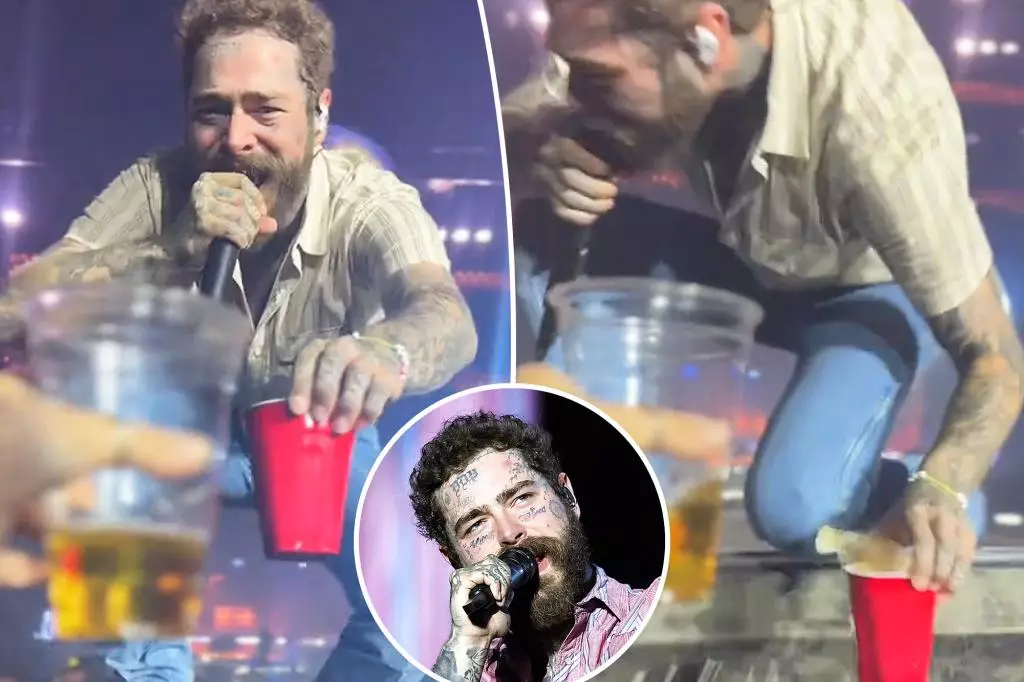Post Malone’s reputation as a charismatic performer is undeniable. His energetic stage presence and genuine connection with fans are core elements of his appeal. However, this high engagement often comes with significant physical risks that performers seldom publicly contemplate. Malone’s recent fall while attempting to toast a fan epitomizes the fine line between entertainment and hazard. Artists like Malone often immerse themselves fully into their craft, which can lead to accidental hazards like stage mishaps. While fans revel in the spontaneity, it underscores a harsh reality: the unpredictability of live performances can turn triumphant moments into moments of danger. Malone’s willingness to take risks demonstrates his commitment to making his shows memorable but also highlights the need for safer stage design. The incident reveals how stagecraft sometimes neglects to prioritize the safety of the very artists who bring concerts to life, emphasizing a critical oversight that fans and managers alike should address.
The Hidden Dangers of Live Performance
In previous episodes of Malone’s touring career, similar hazards have lurked beneath his seemingly effortless performances. His fall in St. Louis from stepping into an uncovered hole demonstrates a recurring problem with stage safety protocols. Such incidents are rarely accidental or purely coincidental; they often result from poorly designed infrastructure that fails to account for a performer’s spontaneity. Malone’s resilience after the incident—and his message of gratitude—shows a commendable attitude, but it also exposes a systemic issue within live event production. Artists are required to adapt rapidly when unexpected dangers arise, often risking their well-being. The fact that Malone returned to the stage shortly after his injury reveals a work ethic and dedication that inspire admiration. Nonetheless, these episodes highlight the urgent need for rigorous safety standards that protect performers without diminishing the spontaneity and passion that make live shows captivating.
The Trade-Off Between Fame and Vulnerability
Malone’s experiences serve as a candid reminder that the glamour of stardom involves considerable personal vulnerability. The singer’s willingness to share his injuries and address them transparently fosters a sense of relatability; fans see not just the polished image of their idol but also his human fragility. This transparency can cultivate loyalty and admiration, illustrating that even the most iconic figures are susceptible to mistakes and mishaps. Still, the underlying message is that fame amplifies risks—whether in the form of physical dangers, mental pressure, or the relentless scrutiny that accompanies every stumble. Malone’s resilience in the face of injury signals a broader cultural shift: modern performers are becoming more open about their challenges, thereby fostering a culture of authenticity rather than perfection. It’s a reminder that behind every powerful performance lies a foundation of perseverance and the acknowledgment of personal limitations.
Reimagining Live Music Safety and Authenticity
This series of incidents invites industry stakeholders to reconsider how concerts are staged and managed. While the thrill of spontaneity adds to a show’s charm, safety must remain paramount. Better stage design, proactive hazard assessment, and improved planning could prevent many of these mishaps without compromising the electrifying atmosphere of live performances. Malone’s fall, although seemingly minor in the grand scheme, illustrates how easily a concert can turn tragic if precautions are overlooked. The challenge is balancing the authenticity and excitement that define live music with meticulous safety protocols. Artists, managers, and production teams must embrace rigorous standards that prioritize health without sacrificing authenticity. The future of live entertainment hinges on this delicate balance, and Malone’s experiences could catalyze meaningful change in how tours are planned and executed.
By confronting these hazards head-on and fostering a culture that values artist well-being alongside audience engagement, the industry can elevate the quality and safety of live performances. Malone’s resilience amid adversity offers an example of unwavering dedication, yet it also serves as a powerful call to action for everyone involved in the spectacle of live music.

